BEST Curry Powder
This post may contain affiliate links. See my disclosure policy.
If you’re looking for the BEST curry powder recipe, look no further! The flavor and aroma of this curry blend is an absolute feast for the senses and hands down beats anything you’ll find at the grocery store!
For more homemade Indian spice blends be sure to try our Garam Masala, Chaat Masala, and Panch Phoron!
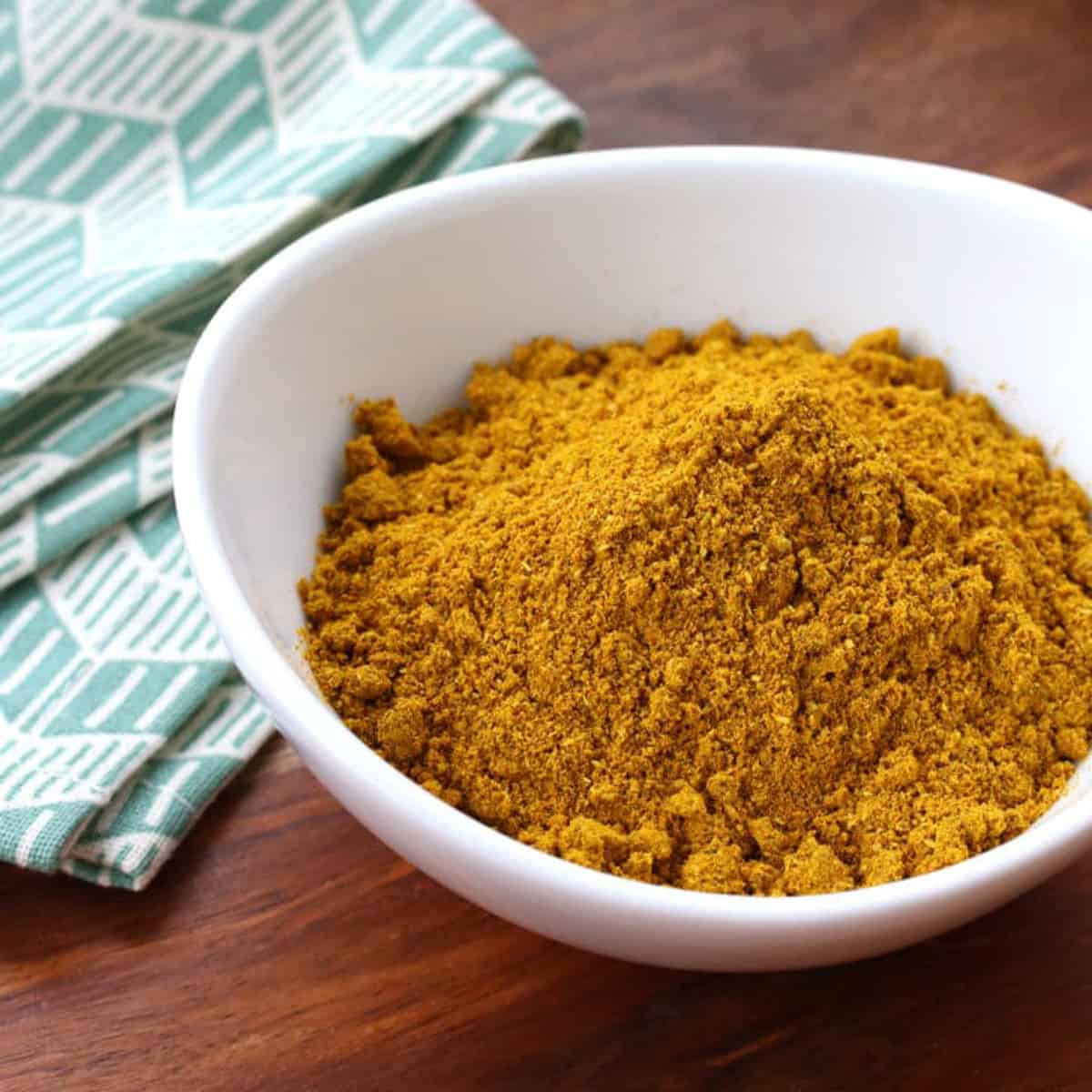
Growing up my mom made Indian food on a regular basis and the smell of cardamom, coriander, fennel and other spices wafting from the kitchen was a sure way to whet our appetites. Here’s a recipe for homemade curry powder, a versatile spice blend you can use in a whole host of Indian-inspired dishes. This curry powder recipe is the ultimate blend of carefully balanced spices that will deliver flavor and fragrance to your food!
Where Did Curry Powder Originate?
You may think the answer is obvious: “Duh. India.” But you may be surprised to know that curry powder doesn’t exist on the Indian subcontinent and is in fact an 18th century British invention.
Whereas most Indian recipes use a variety of different individual spices, curry powder was Great Britain’s way of simplifying Indian cooking in a way that was easily accessible to the British home cook who would otherwise have found it difficult to acquire some of these spices. British manufacturers developed a pre-made blend of Indian spices, called it “curry powder”, and sold it in tin cans (popular brands that still exist include Sharwood’s, The Original Ship/Green Label and Crosse & Blackwell). Now cooks could take out a scoop or two of “curry powder,” add it to their meal, and enjoy a full array of Indian flavors.
It was during this same time period that British cookbooks started including recipes for “curry sauce,” another British creation. The term “curry” is the anglicized version of the Tamil word kari, which translates to the generic word “sauce.” In Great Britain, “curry sauce” referred to a specific dish that used curry powder. And this “curry sauce” has since become world renowned and conjures up an immediate recognition and expectation of what it will taste like.
Curry Powder Ingredients
There is no standard recipe and both the selection of spices and their ratios vary from recipe to recipe and from brand to brand. However there are several spices that more often than not are included in curry powder and those include coriander, cumin, turmeric, cinnamon, ginger, fenugreek, fennel, curry leaf or bay leaf, garlic, black pepper and red chilies. Cardamom is sometimes included though less commonly. The cardamom flavor is featured more commonly in Garam Masala. For spicy-hot curry, more red chilies and yellow mustard seeds are added.
These spices can be added in any number of different ratios which will give more emphasis to one flavor over the other. My goal in developing this curry powder recipe was to create a good balance of all the flavors, each one complementing rather than rivaling the other. And I also wanted to replicate the flavor of my favorite British curry powder brands that I came to love during the years I lived in England. This carefully crafted blend will give your food a remarkable depth and complexity of flavor and we’re confident you’re going to love it as much as we do.
Do I Have to Use Whole Spices?
No, but we HIGHLY recommend it. The natural oils in spices is where the flavor is concentrated and these oils are highly perishable once the whole spices have been ground. The pre-ground spices sold in stores have been sitting in jars for a long time and their flavor is bland in comparison to freshly ground spices.
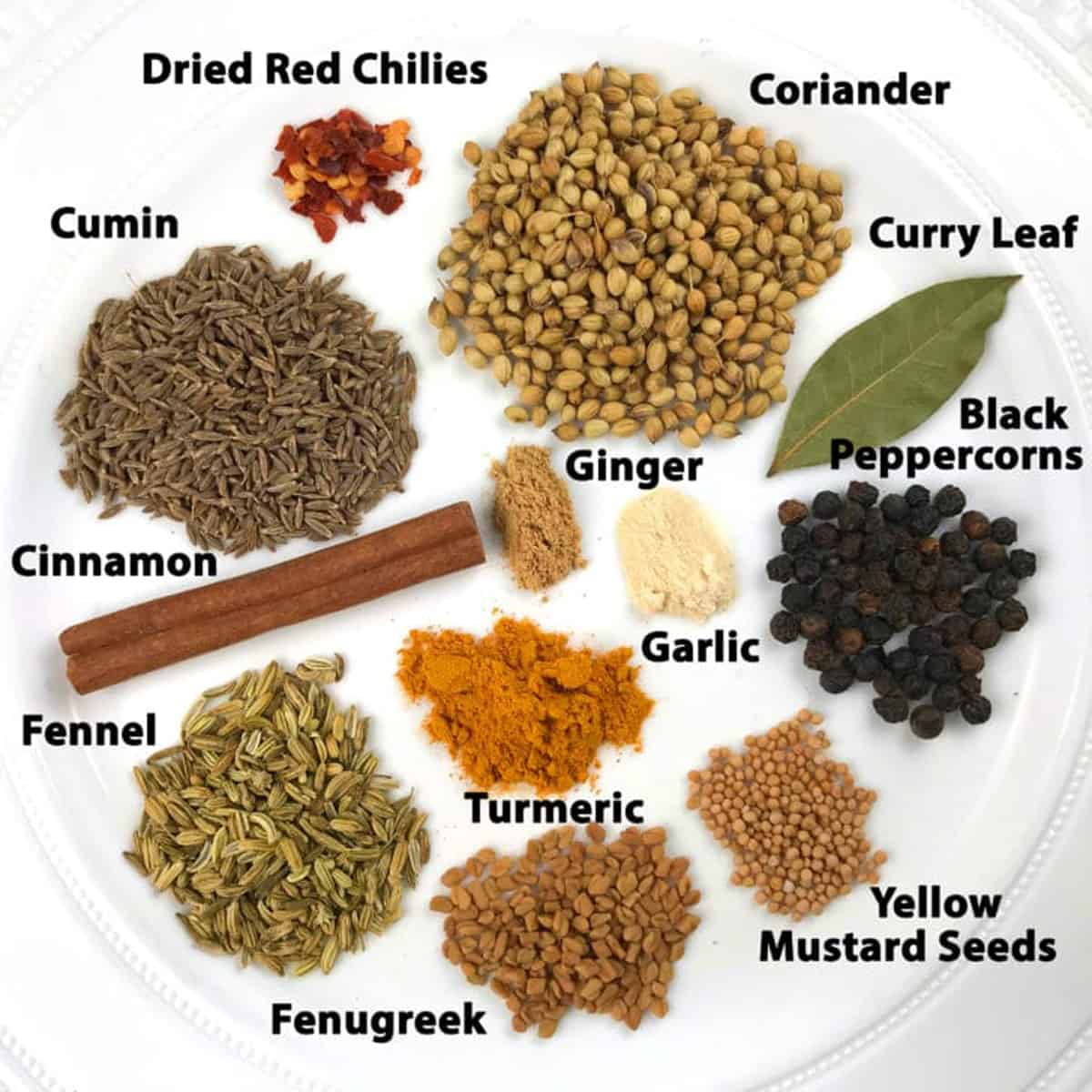
Curry Powder vs. Madras Curry Powder
They both have the same ingredients and thus the same flavor, but they differ in their level of heat. Standard curry powder is milder whereas madras curry powder is hot. This heat come from adding more red chilies as well as yellow mustard seeds. You can easily adapt this recipe to make madras curry powder by adding these two ingredients.
Curry Powder Recipe
Making your own couldn’t be any simpler. The only remotely challenging part may be finding the needed spices. But I’ve provided links in the recipe box to where you can conveniently find them on Amazon if you can’t find them locally. Once you have all the spices all you have to do is dry-roast the whole spices in a skillet and then grind the cooled spices together with the remaining spices.
Let’s get started!
Heat a skillet over medium heat and roast the whole spices and curry/bay leaves for a few minutes until very fragrant. Be careful not to scorch the spices or they will be bitter. Let the spices cool completely.
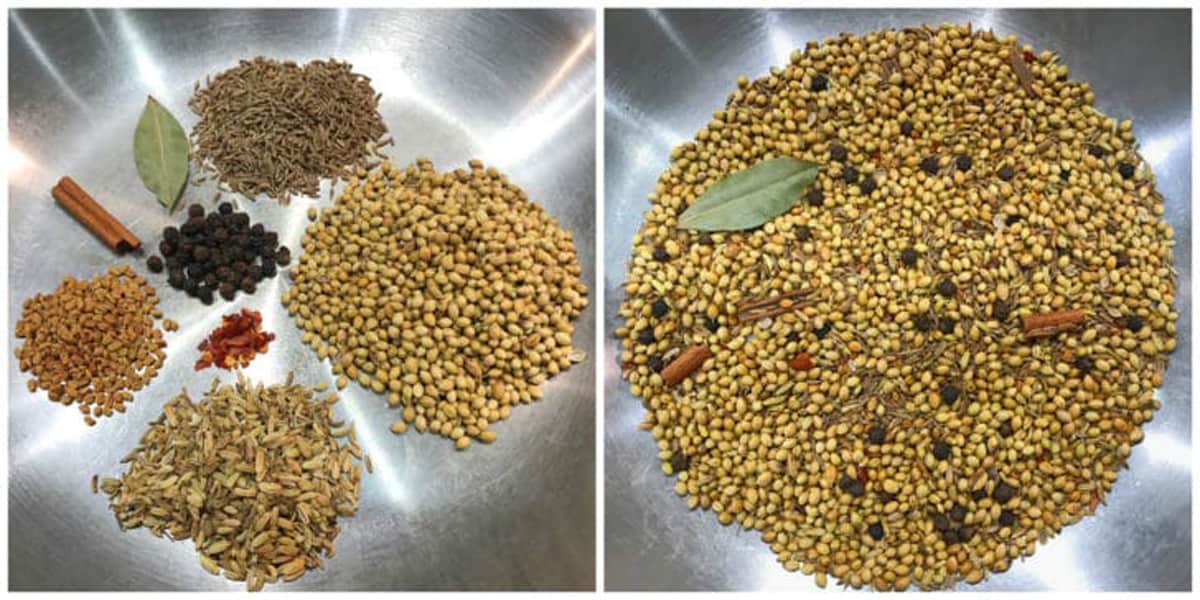
Once completely cool, place the toasted whole spices in a spice/coffee grinder along with the remaining ingredients and grind until you get a fine powder.
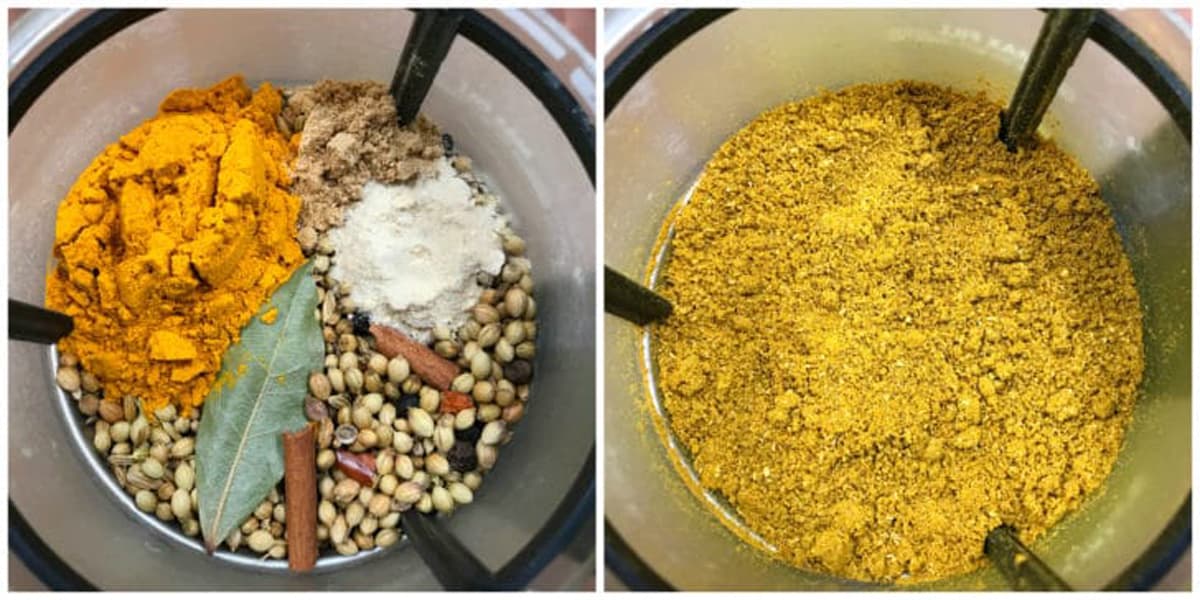
How Long Does This Keep?
Because the natural oils in the whole spices perish fairly quickly one the spices are ground we always recommend making seasoning blends in small batches so that you can use them up quickly. While this blend will keep for several months (and still taste better than store-bought) the flavor potency will weaken over time, so for maximum flavor it’s best to use it within a few weeks. Store the spice blend in an airtight jar in a dark, cool place.
Enjoy!
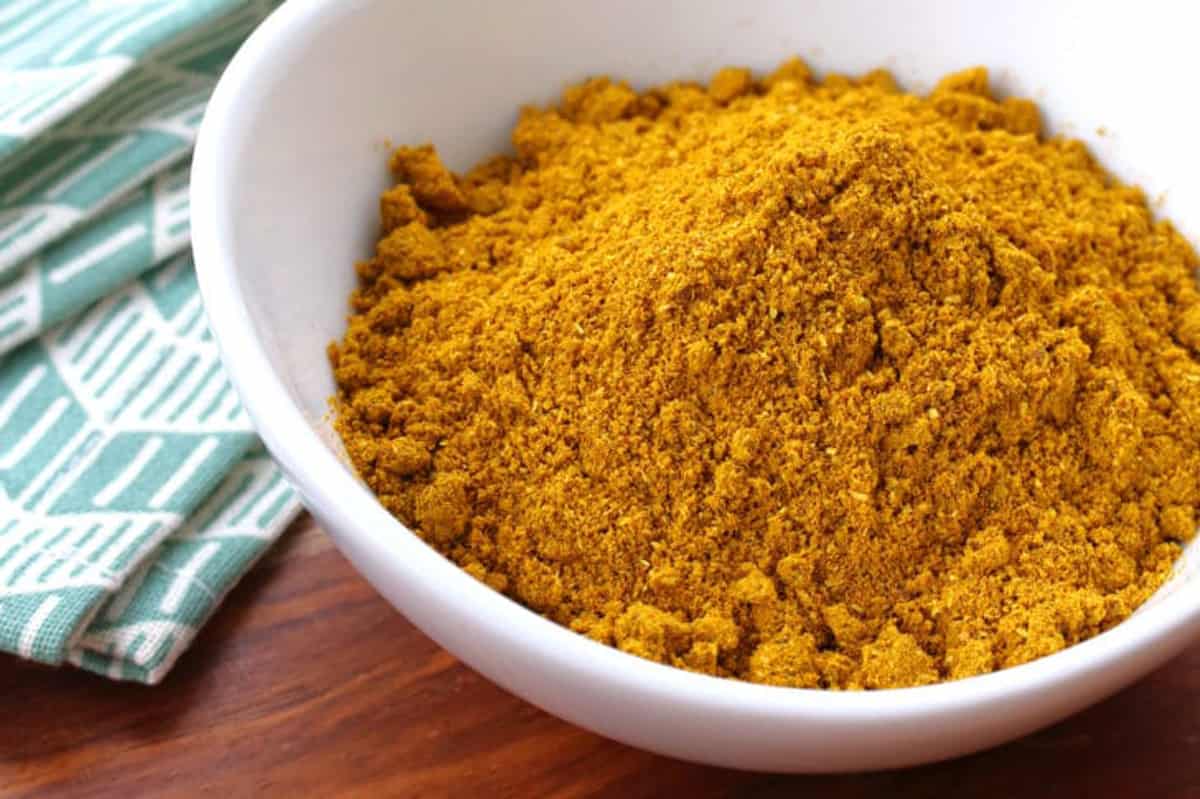
For more delicious homemade seasoning blends be sure to try my:
- Greek Seasoning
- Old Bay Seasoning
- Creole Seasoning
- Montreal Steak Seasoning
- Jamaican Jerk Seasoning
- Sazon Seasoning
- Poultry Seasoning
- Pickling Spice
- Shichimi Togarashi
- Elote Seasoning
- Dukkah
- Za’atar
- Chinese Five Spice
- Chili Powder
- British Mixed Spice
- Porcini Salt
- Pot Roast Seasoning
- Berbere
Save This Recipe
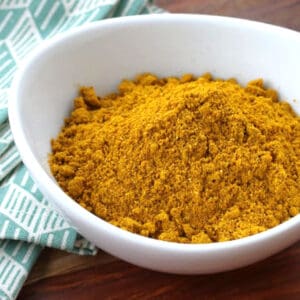
BEST Curry Powder
Equipment
Ingredients
- 1/4 cup coriander seeds
- 4 teaspoons cumin seeds
- 1 tablespoon fennel seeds
- 1 teaspoon fenugreek seeds
- 1 teaspoon black peppercorns
- 1 teaspoon yellow mustard seeds (optional, for added heat)
- 4 small dried red chili peppers
- 4 dried curry leaves (can substitute 1 large bay leaf)
- 2 tablespoons ground turmeric
- 1/2 teaspoon ground ginger
- 1/2 teaspoon garlic powder
- 1/2 teaspoon salt
- 1/4 teaspoon ground cinnamon
Instructions
- Heat a skillet over medium heat and roast the whole spices and curry/bay leaves for a few minutes until very fragrant. Be careful not to scorch the spices or they will be bitter. Let the spices cool completely. Place the whole spices in a spice/coffee grinder along with the remaining ingredients and grind until you get a fine powder. Store the curry powder in an airtight jar in a dark, cool place. Will keep for several months but for best flavor use within a few weeks. Makes approx. 1/2 cup of curry powder.
- To Make Curry Paste: Combine 1 tablespoon of curry powder with 1 tablespoon of water and 1 tablespoon of oil and mix together. You can also add some finely minced garlic and ginger. (You can use larger quantities of the paste ingredients and puree everything together in a blender.) For a Thai curry paste replace the water with fish sauce and add a squirt of lime juice.
Video
Nutrition
Originally published on The Daring Gourmet January 28, 2020



















Hi,Im glad that i found this recepi. Waiting to try it. Meanwhile, this curry powder is used for meat only right or can it used for fish curry as well?
Hi Riya, this curry powder is “all-purpose” and can be used for meat, poultry, fish, and vegetables.
Great, Thank you so much.
Hi – notwithstanding the fact that curry powder is not, as one of your commenters indicate, authentically Indian, this mix is one of the best I’ve made in a very long time. Though not Indian, I make many Indian dishes, and usually the ‘curry’ unique to the dish I’m making. But sometimes I like to use a premixed curry powder, and quite frankly most of the commercial offerings are just not that good.
I was just reminded to make this comment just now, as I’m finishing off a meal in which I used this mix. As I sniffed my stew, the warmth of this curry just wafted towards me. It’s the warmth that you smell with this curry powder mix, and it is almost as potent as when I made this about 4 or so months ago. I’m just finishing off my batch and will make it again!
Thank you, Nora, I’m so glad you enjoyed it! And yes, as I discuss in my blog post about the history of curry powder, the blend was created by the British.
My hunt for nice Indian curry continues, though your recipe is the best i have found so far. I admit I make Japanese curry mostly, Though this is not authentic it does meet the taste bud test. thanks, Dr. Elaine
Greta post! Can’t wait to try this!!
Kimberley
The curry powder, not to blast non-Indians, is rather a misnomer. The spice combinations quoted in your recipe of a curry powder is a poor-mans understanding of how to use the spices that are part of the Indian cuisine. However this is not a bad substitute as long as the outcome is something that is desirable.
Depending upon the region of India we hail from and the entrée we may be preparing, it is a combination of the aforesaid spices that are use selectively in conjunction with other ingredients like yogurt, ginger and/or garlic (whole and/or as a paste), cilantro leaves (as part of the main cuisine or for garnishing) or curry leaves (limited to Sothern Indian style of cuisine ) and at least another 5-10 other ingredients . Garam Masala can be plain or “shahi” (meaning royal or regal) , where it could be simply cinnamon, cardamom and cloves roasted and ground) or the same ingredient combined with star anise, kabab chini, mace, nutmeg and probably another 4-5 other spices. Tomato is another such ingredient which when used carefully makes a whale of a difference.
To obtain the correct flavor if you “really” wish to make an authentic entrée, constitutes an understanding of how and when and which of these spices and ingredients are used and in what proportion.
All in all the above curry powder recipe may be a good substitute to satisfy the craving, but it is something that you will never find as a single ingredient in the repertoire of spices that you could find in the pantry of an Indian household.
My comments here are intended to clear out the myth of the so called “curry powder”. I have been asked how to make a good curry powder and I cringe at the mention and politely wax ignorance emphasizing that there is no such thing.
Pardon my intrusion in your serene world of so called curry powder based cuisine.
Adieu
Hi Swarna, thank you for your insights. Agreed, curry powder is not an authentic Indian product and if you read the section of my blog post, “Where Did Curry Powder Originate?”, you’ll find that I’ve already addressed that myth.
Swarna, I’m looking for the best “packaged” Curry Powder that tastes the most authentic. I was wondering if the Madras comes closest to being authentic–as that is the one you mentioned above in your comments. Thanks so much!!! I LOVE curry, and I just can’t seem to find the “one” that tastes like the curry my friend sent to me. Hers was authentic.
Honestly, Swarna, you sound like a passive aggressive, pretentious poseur who did not comment to teach, but to display your arrogance and snide demeanour. If you had read her article carefully, you can clearly see that Kimberly fully addressed the history of ‘curry powder’ and the fact that it is not authentically Indian, so your bloviating diatribe was actually quite unnecessary.
Pardon my intrusion into your impertinent world of unwarranted condescension.
Adios.
Do I need to roast the bay leaf in the skillet? I can’t imagine grinding a bay leaf into a fine powder. Does it get that fine?
Hi Cheryl, yes, and it does grind into a fine powder.
Hi… This looks to be one the best curry powder recipes I’ve seen on the web. Having said that, is the amoun of turmeric correct? x2 Tablespoonfuls of turmeric seems like quite a lot. Are we sure it shouldn’t be only x2 teaspoons?. When you watch professional Indian chefs cook a curry — using separate spices and not a one-for-all curry mix — they only use the tiniest bit of turmeric in each recipe: no more than half a teaspoon of turmeric. I think I may just follow this recipe but only use x1 tablespoon of turmeric.
Thank you, Chris! Yes, 2 tablespoons is correct. I looked back on my handwritten notes and saw that at one point I used only 1 tablespoon of turmeric but in the end, after more experimenting with the flavor ratios, decided on 2 tablespoons. You can certainly adjust it to your taste. The way I often test my blends is to sprinkle a little on a bite-sized piece of chicken breast, fry it up. and taste it. Then I tinker with the ratios and then test it again. You can always start with less of something and then add more.
We have a black and white pepper allergy in the family. Can’t tolerate it at all. How would you recommend adjusting the recipe to accommodate that?
Hi Patrice, you can simply omit the pepper; no other adjustments necessary.
Two questions!
First: Does it matter how old the unground whole spices are? The biggest problem I have is finding the constituent whole spices in small enough quantities that I won’t have several cups leftover.
Second: I often use fresh whole ginger, turmeric, and garlic in my cooking so I always have some of each of these on hand. What is the best method to use to dry and grind these into powdered versions?
Hi H. Liz, the older the spices the less flavor they will have. Test them by grinding them and see how fragrant they are. For your second question, you could dehydrate sliced ginger, turmeric and garlic in a food dehydrator and once fully dried you can grind them to a powder in a blender or spice/coffee grinder.
Hey. Is it possible
to make Thai green curry without Cumin? Thank you
Hi Roselyne, absolutely, if you prefer no cumin simply omit it.
Hi, I have fenugreek leaves, can I use that instead of fenugreek seeds?
Hi AnnHu, the leaves have a different flavor profile than the seeds. You can certainly add some leaves if you like but I would probably just omit it if you don’t have the seeds. The curry powder will still taste very good even without it.
It seems lovely. How would you convert this into a curry paste? Thanks
Hi Rita, simply combine 1 tablespoon of curry powder with 1 tablespoon of water and 1 tablespoon of oil and mix together. For a Thai curry paste use 1 tablespoon of fish sauce and 1 tablespoon of oil along with a squirt of lime juice.
Thank you! No minced ginger or garlic?
Hi Rita, some fresh garlic and ginger are great additions, especially if whatever you’re adding the paste to doesn’t already include them.
I love making my own curry! Can’t wait to try this!
Wow I never even realized that you could make this at home yourself! Thank you for the easy recipe!
This is awesome! Just in time for my curry dish I’ll be making soon!
This is the best blend of flavors around! So easy to put together too!
I’m so glad you enjoyed it, Suzy, thank you!